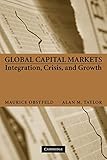Global capital markets: integration, crisis , and growth/ Maurice Obstfeld, Alan M. Taylor
Publication details: New York: CUP, 2004Description: xviii, 354 p. PBISBN: 9780521671798Subject(s): International finance -- History. Capital market -- History. International economic relations -- HistoryDDC classification: 332.042| Item type | Current library | Call number | Status | Date due | Barcode | Item holds |
|---|---|---|---|---|---|---|
|
|
Central Library, Sikkim University | 332.042 OBS/G (Browse shelf(Opens below)) | Available | 46661 |
Section 1. Global Capital Markets: Overview and Origins: 1. Theoretical benefits; 2. Problems of supernational capital markets in practice; 3. The emergence of world capital markets; 4. The trilemma: capital mobility, the exchange rate, and monetary policy; Part II. Global Capital in Modern Historical Perspective; Section 2. Globalization in Capital Markets: Quantity Evidence: 5. The stocks of foreign capital; 6 The size of international flows; 7. The saving-investment relationship; 8. Caveats: quantity criteria; Section 3. Globalization in Capital Markets: Price Evidence: 9. Real interest rate convergence; 10. Exchange-risk free nominal interest parity; 11. Purchasing power parity; 12. Caveats: price criteria; 13. Summary; Part III. The Political Economy of Capital Mobility; Section 4. Globalization in Capital Markets: A Long-Run Narrative: 14. Capital without constraints: the gold standard, 1870-1931; 15. Crisis and compromise: depression and war, 1931-46; 16. Containment then collapse: Bretton Woods, 1946-71; 17. Crisis and compromise II: the floating era, 1971-99; 18. Measuring financial integration using data on legal restrictions; Section 5. The Trilemma in History: 19. Methodology; 20. Data sources; 21. Stationarity of nominal interest rates; 22. Empirical findings: pooled annual differences; 23. Empirical findings: individual-country dynamics; 24. Conclusion; Section 6. Sovereign Risk, Credibility and the Gold Standard: 25. Five suggestive cases; 26. Econometric analysis; 27. Conclusion; Part IV. Lessons for Today; Section 7. Uneven Rewards: 28. Foreign capital stocks: net versus gross; 29. Foreign capital flows: rich versus poor; 30. Foreign capital stocks: rich versus poor; 31. Then: has foreign capital always been biased to the rich?; 32. Now: have poor countries really liberalized their markets?; 33. Variations in the types of capital flows; 34. Summary; Section 8. Uneven Risks: 35. Open markets, crises and volatility; 36. Crises, controls and economic performance; 37. Contagion and self-fulfilling crises; 38. Market failure, government failure and policy choices.


There are no comments on this title.